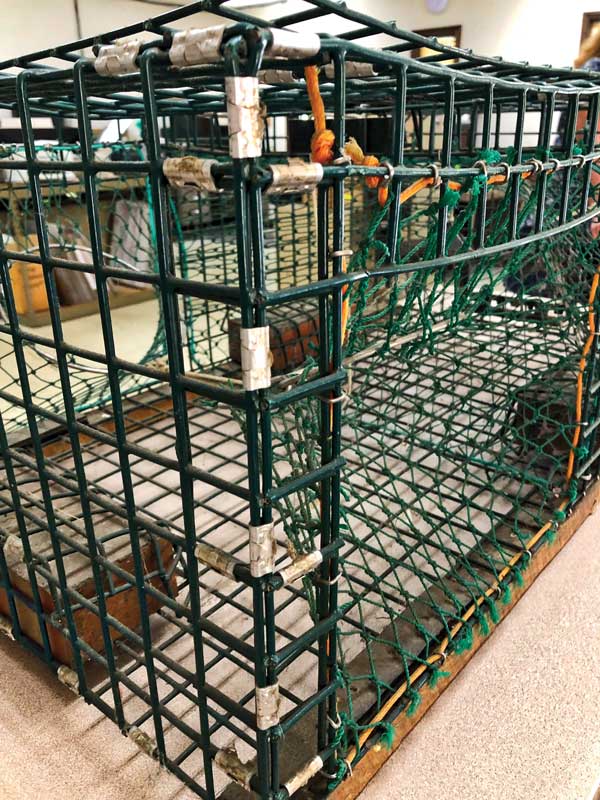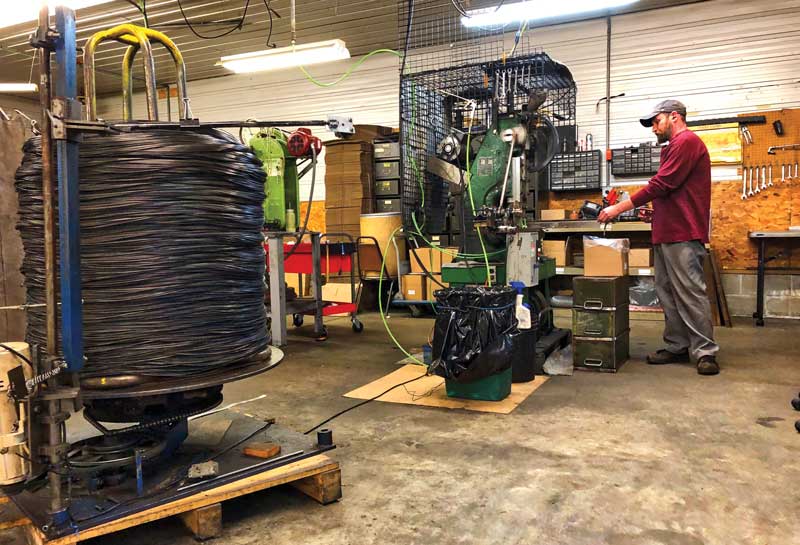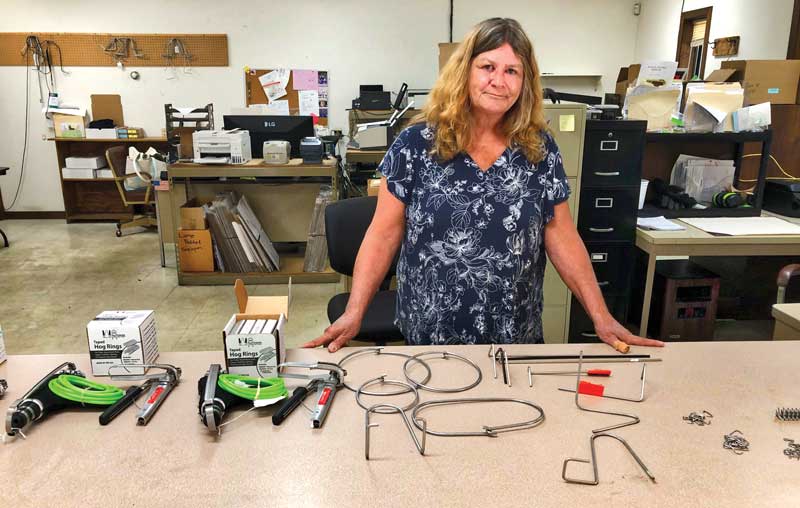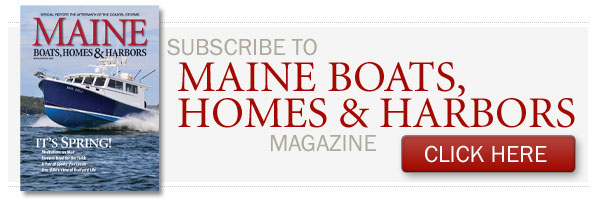 WA Fasteners manufactures the little-noticed fasteners, clips, metal rings, and other parts that hold together lobster traps, crab pots, shrimp pots, and oyster-farming cages. Photo by Clarke Canfield
WA Fasteners manufactures the little-noticed fasteners, clips, metal rings, and other parts that hold together lobster traps, crab pots, shrimp pots, and oyster-farming cages. Photo by Clarke Canfield
Look at a standard lobster trap, and what do you see? The first things, of course, are the six coated-wire mesh panels that make up the sides of a trap. You’ll also spot the nylon mesh funnels that lead into the two trap compartments, the kitchen and the parlor. Perhaps the escape vent will also catch your eye.
But the most numerous parts of a lobster trap are the ones you probably don’t even notice: the clips, or fasteners, that clasp the whole contraption together. Lobster traps require dozens of clips—the nitty-gritty little do-dads that hold everything in place.
 Besides making an assortment of fasteners and hoops shown here, the company also makes hand and air tools (at left) that are used to attach the clips and other parts to their traps. Photo courtesy WA Fasteners
Besides making an assortment of fasteners and hoops shown here, the company also makes hand and air tools (at left) that are used to attach the clips and other parts to their traps. Photo courtesy WA Fasteners
The largest manufacturer of these little-thought-of but indispensable parts is a company hidden from view on a country road in the southern Maine town of Pownal. There, WA Fasteners makes tens of millions of clips, hoops, and hog rings that are used to bind wire together, and even the bait spikes that are used by thousands of lobstermen in Maine and beyond.
The lobster industry represents about 90 percent of WA Fasteners’ market in New England, Canada, and even the United Kingdom. But its parts are also sold for crab pots on the eastern seaboard and the Gulf of Mexico, shrimp pots and nets in the Gulf, and oyster farming cages along the eastern seaboard, in Canada, and in the Pacific Northwest.
Outside of its customer base, though, the company flies low under the radar.
“We love the customers, the users,” said Gary Lenhoff, senior vice president at Encore Hartco, a company in Northbrook, Illinois, that has owned WA Fasteners since 2020. “But we don’t really have a whole lot of competition, and we like it that way.”
WA Fasteners was founded in 1974 by Bob and Janice West in the basement of their Pownal home, not far from where the company’s manufacturing plant is now located. Back then it was called the Robert West Co., and it made metal cleats for golf shoes.
West changed course to the fishing industry in 1981, manufacturing lobster trap hoops and hog rings, later adding fastener clips to the product mix in 1985. The company was renamed WA Machine before eventually adopting its current name, WA Fasteners. The WA stands for West Automation.
Bob West made his own manufacturing machines, customizing them to make the clips and other parts. The company today has 11 machines, seven of which were built by Bob West, said Cheryl Meyer, the general manager of the plant.
 To make its products, the company uses specialized machinery (above) to transform large coils of aluminum and steel into products used by fishermen and trap makers on the Atlantic and Pacific coasts, in the Gulf of Mexico, in Canada, and in the United Kingdom. Photos by Clarke Canfield
To make its products, the company uses specialized machinery (above) to transform large coils of aluminum and steel into products used by fishermen and trap makers on the Atlantic and Pacific coasts, in the Gulf of Mexico, in Canada, and in the United Kingdom. Photos by Clarke Canfield 
The original machines were made with sewing machine motors, she said. Through the years, West also used crank shafts, cam shafts, connecting rods, and other car parts in his machines, including some from an old Studebaker at one time.
The operation moved from West’s basement to its current home in 1990. The 10,000-square-foot, aluminum-sided building sits far back from the road, shielded by trees. There’s not even a sign out front.
Ready to retire, West sold his business in 2020 to Encore Hartco. Its founder and president, Don Ayres, originally met West at the Maine Fishermen’s Forum in Rockport.
Encore Hartco makes similar clips at its Northbrook plant that are used to hold springs and wires together in mattresses and couches, as well as products used in the manufacturing of concrete pipes used in drainage and water systems. Ayres had long figured that WA Fasteners’ product line would complement the Encore Hartco mix.
In fact, Encore Hartco at one time tried manufacturing its own lobster trap products to compete against WA Fasteners, but found it hard to crack the Maine market, Lenhoff said. Maine buyers were comfortable with WA Fasteners and liked that it was in Maine. In the end, Encore Hartco bought the company. “It’s a wonderful complement for us,” Lenhoff said. “It fit like a hand in a glove.”
Inside the plant, strips of aluminum and steel that are rolled into huge coils are fed into the machines, each with a distinct role in producing a dizzying assortment of products. One machine chops the aluminum into the small clips at the rate of 3 or 4 per second. Another machine spits out five hog rings per second. And still another machine makes the traps’ hoops, which attach to the nylon mesh inside the traps.
Four days a week, the machines crank out the parts—thousands upon thousands of them. When the machines are running, employees wear ear plugs to muffle the loud nonstop clackety-clack, clackety-clack!
 Cheryl Meyer, general manager of WA Fasteners, has worked at the plant in Pownal for 19 years. The hog rings in the box at the left are used to fasten things together, and are named for the rings farmers inserted into pigs' snouts to prevent them from burrowing in the ground and to lead them. Photo by Clarke Canfield
Cheryl Meyer, general manager of WA Fasteners, has worked at the plant in Pownal for 19 years. The hog rings in the box at the left are used to fasten things together, and are named for the rings farmers inserted into pigs' snouts to prevent them from burrowing in the ground and to lead them. Photo by Clarke Canfield
Besides the various trap parts, WA Fasteners also makes hand and air tools that fishermen and trap makers use to attach the clips and other parts to their traps.
For the most part, WA Fasteners sells its lobster trap offerings to marine supply stores and trap manufacturers, such as Hamilton Marine and Brooks Trap Mill in Maine. Trap makers need the products to assemble their traps, and marine supply stores sell them in boxes to fishermen, primarily in the fall when they bring their traps to shore and repair them during the cold-weather months.
When West owned the company, he didn’t have a website, didn’t advertise, and didn’t take credit cards, accepting only checks and cash. Business spread by word-of-mouth and the customer base grew through the years.
Meyer said West built relationships with fishermen, who relied on him for the clips, hoops, hog rings, and other parts that were vital for their business. In her 19 years at the company, Meyer too has developed relationships with fishermen.
“I like interacting with the fishermen,” she said. “You can talk to them. They’re real.”
✮
Clarke Canfield is a longtime journalist and author who has written and edited for newspapers, magazines, and the Associated Press. He lives in South Portland.






